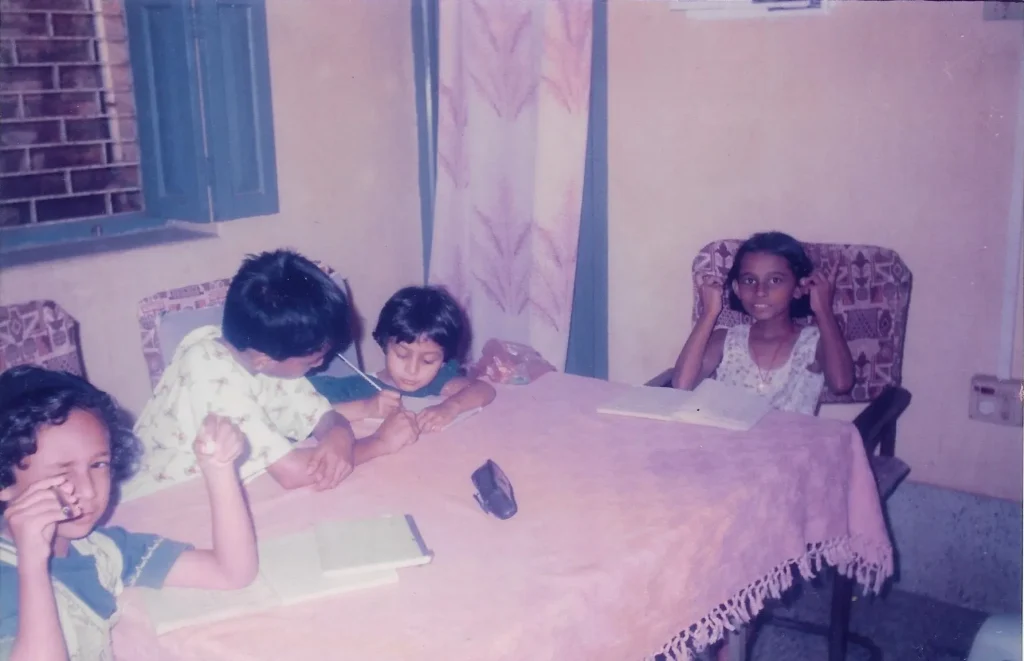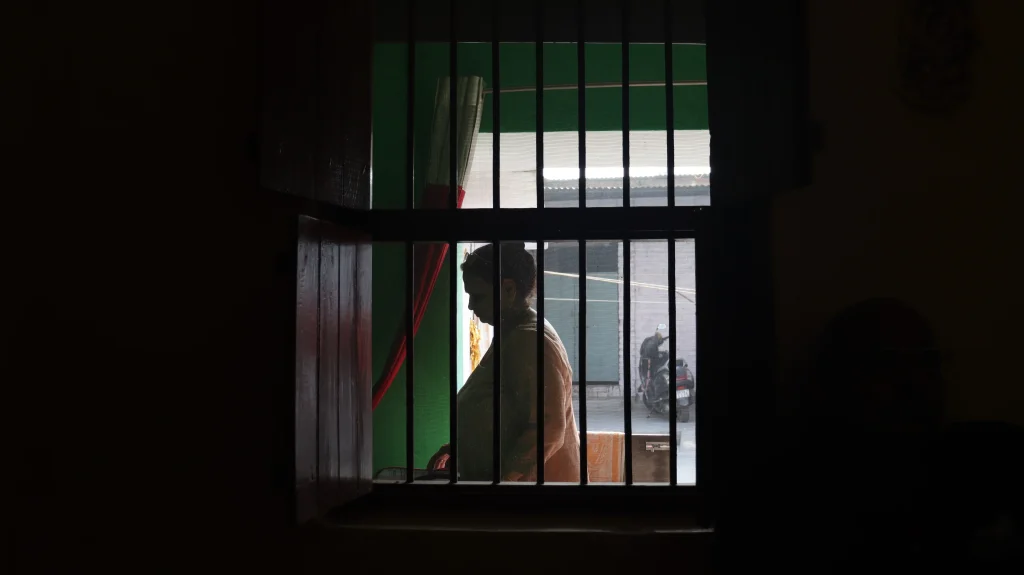Looking for Mother Lodge
by Rini Rayna
An exploration of intergenerational legacy and nostalgia through family photographs and fragmented personal memories, while coming to terms with migrant subjectivity.

A family portrait with Late Yogmaya Ghosh standing in the centre; year and place unknown.
Courtesy of Abha Ghosh.
“Home is where one starts from.”
– T. S. Eliot
Somewhere between the known and the unknown, lies ‘Mother Lodge’, a plot of land that once included pakka (permanent) and some kaccha (temporary) houses made out of phoos (hay) and bamboo. These were rented out by my great-grandmother, the Late Yogmaya Ghosh to students of the nearby Industrial Training Institute and later to families. My mother’s paternal home, Mother Lodge in Mirchaibari (Katihar, Bihar), is where several vignettes from the past lay silently entwined in memories, of my own and those borrowed from my family. It is a home where the whiff of the morning chai (tea) being brewed in a kettle is still embedded in my soul—a place where I have always been welcomed with love and warmth. Above all, it is the portal to a landscape steeped in nostalgia, a spatial companion in my mother’s life before she got married and shifted to Bombay (now called Mumbai), the megacity.

Nanaji balancing my cousin on his shoulder, while another cousin smiles behind, 1994.
Courtesy of Ritika Raj.
This Home, That Home
Having lived in different homes, I have learnt that, like us, they too, shed and acquire new meanings with time. The objects we adorn our private dwellings with, the people who arrive and depart from there, and the familiarity and longing they carry—all remain enmeshed in our identities, no matter where we go. As a child who visited Bihar only during summer vacations, weddings, or emergencies, both Mother Lodge and Geeta Villa (my father’s paternal home in Purnea) were temporary places that offered a safe space for wandering aimlessly with my cousins, sipping orange squash and playing ‘teacher-teacher’ (a child’s game of play acting as teacher and student). Eating puri-bhujiya, kaala jamuns from Jagdamba Sweets and Maago’s (my grandmother’s) chutneys, and visiting the City Kaalibari were some of the small joys we cherished together as a family. Some of the kids, like I, came from other places and our camaraderie briefly infused these ancestral homes with cheerfulness. Such holidays validated that we ‘belonged’ to Bihar, and yet, it wasn’t our ‘home’. Where was home then?

I (on the extreme right), my brother and my cousins, playing ‘teacher-teacher’. Hanging around in a shameez (chemise) in summers was a childhood luxury. In Geeta Villa, Purnea, 2002.
Courtesy of Author’s family.
For over two decades, I have been staying in a planned satellite town called Navi Mumbai, a motif of modernization and a destination that still promises bright futures to many migrants like us. Over the years, I have seamlessly blended into the cosmopolitan culture here and have spent the majority of my life considering this place my ‘home’. Eating diverse cuisines, shopping at malls, and making friends of all ethnicities never allowed for sufficient time to look beyond what was at hand. However, amidst the annual Ganpati pujas, local train journeys, and my Bambaiyya slang, we always reserved space for our checkered gamchas (cotton towels), Ma’s Madhubani-painted sarees, Kaalnirnay calendar, farras and littis (native snacks) — symbols of our Bihari-ness, that occupy a special place within our fragmented sense of belonging. With each passing day, I am growing conscious of how my parents have safely carried these peculiarities in their consciousness in ways that have almost made them sacrosanct.

My Nani performing the Jamai Shashti Puja at our Jawaharlal Nehru Port Trust Township flat in Navi Mumbai, 1993.
Courtesy of Author’s family.
Between the Territorial and the Personal
During the COVID-19 pandemic, when my paternal grandparents and Uncle passed away, I was left with a trail of unresolved questions. I spent those grief-laden days, sporadically living in our many homes in different parts of India. In hindsight, those days were instrumental in making me realise that family losses and the experience of bereavement make one more aware of what is and was, rather than anticipating what is yet to come. I instinctively began to see Ma, Mother Lodge and Bihar—all in a new light, and gradually they seemed like living archives from distant places and times, waiting to be unveiled. And when they did, their relevance and our history extended far beyond what I had known—into undivided Bengal and Bihar, and Zamindari estates, making the lives of my great-grandparents suddenly seem so palpable and inviting. Fascinating insights like the one about my maternal great-grandfather who worked as a muneem (accountant) for the Raja of Nazargunj, Prithi Chand Lal Chaudhari, drove me significantly in my pursuit for unearthing further—all that had long remained unspoken in our family for decades.

Ma, during our recent visit to Mother Lodge in 2023.
Courtesy of Author.
To date, when Ma retires from the domestic chores at night, we talk about her past in and around Mother Lodge. I can feel its distance and weight evident in the wrinkles of her skin and the detachment in her voice. Yet, each conversation reveals something intriguing and surreptitiously leads me into the deep recesses of her memory that nobody seems to have excavated before. I often jokingly accuse her of hiding her past but she says that I had never bothered to ask. I wonder how I became so indifferent towards my origins, heritage and land. Maybe, the hustle and bustle of life in a new town intensified the distance between me and Mother Lodge, effacing the attachment I once had for it, as a young girl.
That young girl’s notions of home and belonging get distorted when I coerce Ma to divulge more so that I can connect the dots. I recollect the details from our recent trip and feel alarmed by the degree of architectural transformation that has swept Mother Lodge. The baithak (semi-open sitting space) outside has repetitively been shifted, a goshala (cowshed) was added but is now used as a store room. Some rooms were once conjoined to function as my Mama’s (maternal uncle’s) N.G.O office and some walls are painted in bright colours. To my disappointment, the one-rupee coin stuck on the staircase tread, which my cousins and I were always preoccupied with, has finally been removed. Other than the native door and window shutters and the peculiar smell of the home, what Ma describes is entirely different from what I recently saw. A heightened sense of displacement tells me that all of us have moved on in our lives. The home, too. And, I have no alternative other than being content with my limited childhood memories, and how the home has remained afloat in everyday conversations, social media and logistical correspondence.
Maybe my efforts to mine Ma’s memory and reclaim the old Mother Lodge are futile. Maybe home is supposed to be a jigsaw puzzle with a few pieces always missing. And the journey of losing and finding them is what life is all about.

The new baithak on the extreme left, 2023.
Courtesy of Author.

Ma’s identity card during her graduation term, Katihar, 1981.
Courtesy of Nutan Sinha.
‘Sh’ and ‘Sa’
Not finding more such pieces hasn’t deterred me from looking for more. Up until a few years ago, my parents’ linguistic oddities—the fact that they couldn’t pronounce certain letters like I (do), used to embarrass me for a split second, earlier. Especially when they pronounce my brother’s name as ‘Bisaal’ and not ‘Vishal’ and ‘pijja’ instead of pizza. However, I don’t feel embarrassed anymore, cognisant as I am of my multicultural roots while recognising that there’s always more to them than meets the eye. I now overhear their phone conversations in Angika—our native dialect—with great pride and curiosity. These epiphanies are how I’m learning to make sense of my multicultural identity and fractured relationship with Bihar, coming to terms with the fact that although our homes have changed, our sentiments for them remain shared and profound.
In these intimate conversations with Ma, I have discovered facets of her existence that would have otherwise remained concealed in our fast-paced, mundane lives. In our newfound friendship, there is an assurance that even though I can never truly find Mother Lodge, I can always gather its fragments, archive and remember it in novel ways. Perhaps, while searching for my mother’s home, I have become more closely attuned to my spirit and body—my first home.

These new rituals of reflection, the familiar sight of the cemented floors, and the distinct, timeless smell lingering in Mother Lodge have all helped me rediscover my notions of home in 2023.
Courtesy of Author.
About The Author
Rini Rayna is a researcher, writer, editor and creative strategist working at the crossroads of media, ecology and culture. She has written for independent publications and creative agencies, approaching her work through an interdisciplinary lens, while seeking to understand how objects, bodies, rituals, borders and migration shape personal and collective histories.
She is on Instagram: @rinirayna
